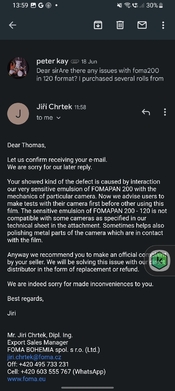I'm currently going through a batch of 013456 3. I am not seeing anything like that.
Do you have an example scan with a film you trust/you're familiar with, processed in exactly the same workflow (same tank, same agitation, etc) and scanned+stored similarly?
Unfortunately not, as this is really my first foray into MF, the only other 120 film I've developed was C41 Lomo CN100 which had no problems. I've kept the Foma 200 in the deepfreeze but no telling how it was kept before then but purchased through Amazon UK. Both the Lomo and Foma were scanned with a Canoscan 9900F - no issues with the Lomo scans.
Other than that my developing has mainly been 35mm, a mix of colour film (developed with Digibase C41) and Foma 100, 200 and 400 B&W, all developed in Caffenol with no issues.




